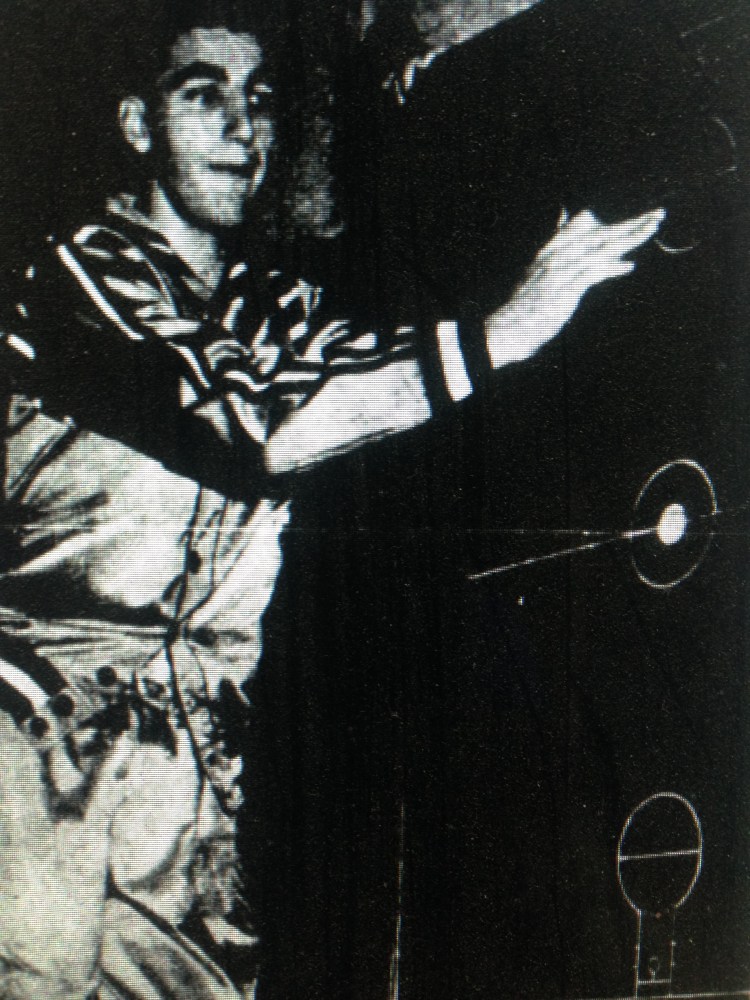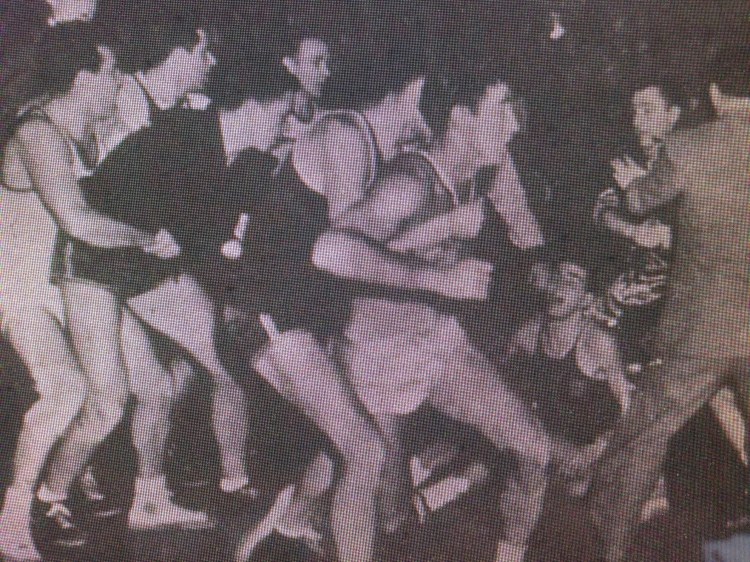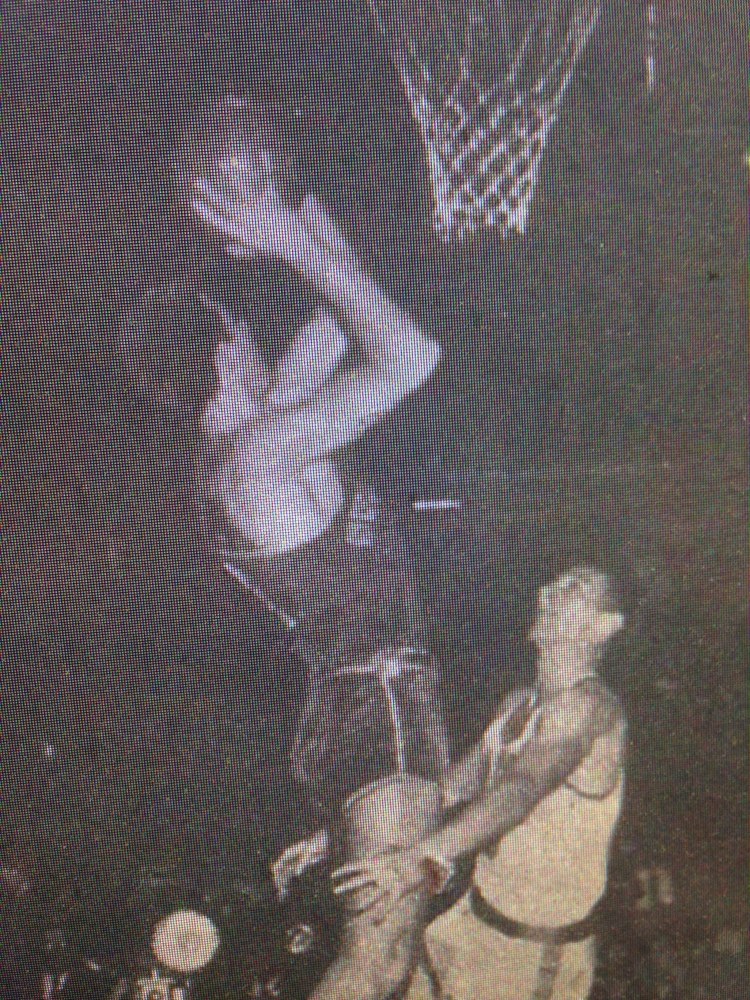[It’s been a long week at work for me, so I’ll keep the intro short. Up next is a March 1953 article that appeared in the magazine Sports Stars. The subject is the young Dolph Schayes, and the byline goes to Leonard Lewin, then in his 30s. Lewin. would go on to great write things about the NBA for the New York Post.]
****
Howard Cann wasn’t sure. He knew that the kid had a great schoolboy reputation at DeWitt Clinton High. But he wondered, as the tall, skinny 16-year-old youngster worked out, how long it would take to make a coordinated athlete out of the ungainly-looking stick of bones. Here it was midseason of the 1944-45 basketball campaign, though, and his New York University team was crying for a big man.
Yes, Cann muttered to himself, NYU could use a big man. But what do I get?—a big kid. Mmmm . . . He looks good, though. He has shots. Look at him hit from outside. And he’s good in the pivot, too. But he’s so uncoordinated. He’s 6-foot-5 and growing, but he doesn’t know how to get off his feet. See how he loses the rebounds to those guys he’s got inches on.
“Get up there, Adolph! Get up there!”
He’s only a freshman, soliloquized the Violet coach, and he’ll learn. No doubt about that. He’s got it. But I don’t know if it’s fair to throw this boy right in with the men. What better way for him to learn, though.
“Up, Adolph! Up, Adolph!”
Adolph went up in more ways than one. Adolph Schayes not only grew to be a strong, 6-foot-7 giant, but he also got to be a man. From a shy, phlegmatic college player, he shot up overnight to become an aggressive, take-charge professional. The transition came so quickly that it stunned everyone he knew and who knew him. It’s much like the surprise a parent gets when a kid talks or walks the first time. You expect it to happen, but you don’t believe it when it does.

That’s the way it was with Schayes. Everyone had a parental love for the kid. You couldn’t help it. He was the type of youngster most parents hope their children turn out to be. He was quiet, courteous, and intelligent. He had all the character attributes of a man, and the physical qualities, too. But his big weakness as an athlete, from the days he entered NYU as a fuzzy-cheeked kid of 16 to the day he left as a fuzzy-cheeked kid of 19, was his lack of aggressiveness. He figured to grow up to be a man in body, but, watching him play in college, you’d have sworn he’d always be a kid at heart.
It wasn’t that he was afraid. There isn’t an ounce of fear in his big body, as the pros have learned. The New York Knickerbocker coach Joe Lapchick, who got his education in the rugged days of the Original Celtics, had this to say about Schayes’ courage:
“In this league, as it’s always been with the pros, they ask you the question right off. They belt you pretty good. Schayes answered ‘em right back, and now he’s one of them. He’s inherently made of the right mold. He’s shown the guys he’s a pretty good belter, too.”
What Lapchick was thinking of was all the near riots which have occurred in the New York-Syracuse series. Almost always, at the bottom of the basketbrawl pile, you’d find a big National with the number 4. That was Adolph Schayes. And almost always, the fellows who knew him as a shy kid at NYU would rub their eyes in disbelief. This hatchet-man, they’d say, couldn’t be the same Adolph Schayes.
But it was. And some of the fellows couldn’t understand the swift metamorphosis, people like former college teammate Ray Lumpp, who’s now with the Knicks. They didn’t realize the part they played in Schayes’ life. In their parental treatment of a timid kid who appeared to need protection, they refused to let him grow up. They carefully tucked Dolph under their wings and fought his battles for him. They evidently mistook Schayes’ humility and respect for sportsmanship as an indication of fear. So, when the big kid got his game scrapes, his protectors came to the rescue before he could defend himself.
There was the time, for instance, when Schayes got himself involved with Tom Muller of Canisius. It was through no fault of his own, unless his unemotional attitude, added to his provoking wealth of natural ability, upset the explosive rival center. In any event, Schayes backed into the pivot, turned to line up his position with the basket, and got smacked on the jaw. Big Dolph, who even now confesses he doesn’t know how or why it happened, went down with Muller on top. Schayes started to fight back but never got the chance. His teammates were at the pile, ready to defend the kid. Despite the nasty attitude of some club-waving Buffalo cops, who were more anxious to break up the NYU players than the scramble, a riot was averted.

Schayes was put out of the game, as was Muller. And, because of the incident, NYU dropped out of [Buffalo’s] Memorial Auditorium competition. But, indicative of the club’s attitude toward him, when Adolph got to the dressing room, the late Jack Weber, Violet trainer, winked at the other players and, with a twinkle in his eye, said to Schayes:
“How many times have I told you not to start fights.”
The players got a laugh out of it. For Schayes was a kid to them; and that’s the cynical way you ride a kid whom you think can’t fight his own battles. And that’s the way it was throughout his 3 ½-season college career, which also included a Philly rumpus with Temple when teammate Tom Kelly beat Schayes to the punch, again by belting a substitute Owl in the eye for him.
This unsolicited protective custody existed in another way, but for an entirely different reason. His Violet mates wouldn’t let him take any shots at the basket either. It was Schayes’ job, in their scheme of things, to make himself subservient to their demands. As Lumpp, a great hook shot, calls it:
“We had some pretty good shooters when Schayes played. So they told him to get in the corner or move into the pivot and pass off when they cut. He never got much chance to shoot. The fellows figured he was big enough to get them the ball and good enough to feed. They’d do the scoring.”
Schayes saw nothing wrong with these methods. He didn’t then as a kid, and he doesn’t now as a man. With his unselfish outlook on everything, Dolph says:
“You gotta figure the team takes about 80 shots a game. We had three great scorers in Sid Tanenbaum, Don Forman, and Lumpp. Each figure to throw about 20 shots. That left 20 or so for the rest of the club.”
To Joe Lapchick, being frozen out by his mates was the pro making of Schayes. The Knickerbocker coach feels that the tactics enabled Dolph to develop his great outside shot when confined to the corners. In addition, he was able to acquire the feeding touch out of the pivot. All Schayes needed was the polish, according to Lapchick, who states:
“Excluding the real big guys, like Mikan, Kurland, and Macauley, there are three college players whom I think had the greatest all-around natural ability. They are Hank Luisetti, Tom Gola of LaSalle, and Schayes.”
To Howard Cann, it was Schayes’ desire to apply himself that developed him athletically. The NYU coach recalls how Adolph used to spend his lunch hours in the gym working with a basketball. It used to amaze Cann how a kid carrying a full complement of engineering studies (and being a top student at it) would spend the only time he had to relax drilling himself on basketball weaknesses.
That’s the way Schayes was from the day he began playing the game as an 11-year-old, 6-foot stringbean. And that’s the way he is today.
“I’ve always loved basketball,” Dolph says. “And I’ve always had a desire to play pro. My first coach was Lou Rossini, now the Columbia coach, who then was playing at St. John’s. I was playing for Creston Junior High School in the Bronx, and Rossini, who lived in the neighborhood, offered to teach us kids. He taught me the New York style, you know, the pick-off and give-and-go, and I’ll be forever grateful to him.
“From then on it was all basketball. What might’ve been work to other guys was pleasure for me. Even to this day, I work hard on things I want to perfect. I realize I need a better left hand in this game. Last season, when I played with my broken right wrist in a cast, I got a good chance to develop my left. But I’m still working on it. And I also realized that the way to beat some of the big guys I play is to be quicker than they are. So, I spend plenty of time on dribbling and feinting maneuvers.”

Cann never has forgotten how Schayes applied himself. And Schayes never will forget Cann, either. Adolph says that his college coach, who was a basketball great himself, is one-in-a-million.
“Cann never tried to interfere with the natural talents of a player. He knows a lot more basketball than most people think. You find out when you make a mistake. But he never puts himself over his players. He accepts the blame and wants the team to have the credit, always. In this day and age, it’s a pleasure to find a man like that, who is first a person and then a coach.”
Schayes, of course, doesn’t overlook the contributions of his present coach. For Al Cervi probably has contributed more to making a man out of the kid than anyone. As things turned out, Adolph and the entire league was lucky that he landed with a weak Syracuse franchise and not the Knickerbockers. As he was this much away from becoming New York property, too. As he remembers it:
“All through my college career, I was thinking of the pros. I thought I had a good chance for some immediate big dough until the 1947-48 National Invitation Tournament game with St. Louis. Then I met up with Ed Macauley. I’d played some tough guys, like Bob Kurland, who seemed two feet taller than me, but no one ever embarrassed me more than Macauley, although he only scored 18 points. He was so quick that I was always going in the wrong direction. I felt terrible, worse than when Notre Dame snapped our 18-game winning streak that season, because I figured it cost NYU a possible Olympic trip.
“I also felt it might hurt my chance of playing with the Knicks. But they soon got around to offering me a $5,000 contract. I held out for more, and they said they couldn’t do it because that was the league ceiling for rookies. I knew it was, but I’d heard other teams were dealing under the table, and I wanted some if I could get it. So, they finally got around to guaranteeing me $700 in playoff money, even if the Knicks didn’t make the playoffs.”
Schayes sat on the offer, hoping to get it raised. And while he was waiting, he got a call from Leo Ferris, owner of the Tri-Cities club in the rival National Basketball League. Ferris told him that he, as a representative of the Syracuse team, which had obtained Schayes’ draft rights from Tri-Cities, wanted to make a deal. They met in New York, and Ferris told Dolph he could have a $7,500 contract, with all the money put in the bank in escrow.
“I thought fast,” recalls Schayes. “I hadn’t heard from the Knicks in about two weeks, and I didn’t like the lack of interest. If they’d have applied some pressure, I might’ve signed at their terms. But Ferris’ offer was so tempting. All that money in the bank, and Syracuse was no Tri-Cities. It was near home.
“While this was going through my mind, Ferris convinced me. He took out a huge roll of bills and offered it as an advance. It turned out to be $500, I think, all in dollar bills. The size of it got me, and so did Syracuse. I’ve never regretted it. This is the greatest sports city in the nation, considering its population, and I love the fans and treatment.”
He was an immediate sensation, of course. The association with Cervi, a fiery leader of the old school, was just the thing for the easy-going Schayes, who had all the talent but lacked only the fire. In Cervi, he joined a coaching-playing pyromaniac, and exploded to Rookie-of-the-Year honors in his freshman season.
They don’t go out of their way to pick on Schayes anymore. The bright youngster who began his college career in the maelstrom of an NYU-Notre Dame battle, in which he had to take All-American Vince Boryla, is now a voting citizen of the courts. It couldn’t have happened to a nicer kid—er, man!

Because of the broken arm, was Dolph a 4-F in the peacetime draft?
LikeLike